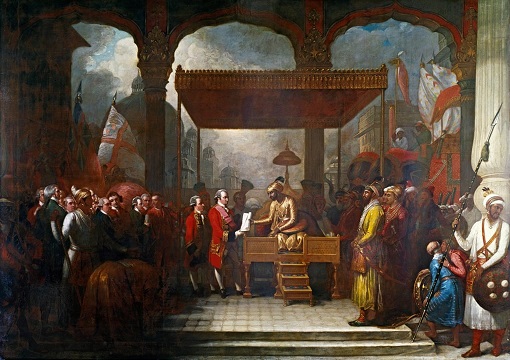Colonialism can be defined as exploitative foreign domination. India’s modern history has been that of prolonged foreign domination. The enlightenment tradition in Europe proved to be a darker phase for India, as it resulted in the colonization of several non-European continents. From steadfast consolidation of foreign rule to a subsequent drain of wealth and market gave a deadly blow to India’s economy.
The agrarian Indian economy was hit hard by the introduction of commercial crops like tea, coffee, indigo, cotton, jute, etc. Colonialism had extensively affected inter-community relations as it fuelled the Hindu-Muslim binary. It followed the proverbial divide and rule policy. Colonialism was considered to have had a positive impact on the social system as it supplanted traditionally conservative values with modern scientific values. A new surge for social change and rethinking of outdated practices became a reality.
Administrative Impact of Colonialism
The colonial history of India was integrally linked to the formation of the British East India Company in 1600. In 1617, the British East India Company got its foothold in India when the Mughal Emperor Jahangir permitted the company to trade with India. Robert Clive made a separate treaty with Mughal Emperor Shah Alam II and Nawab of Awadh Shuja-ud-Daullah. It came to be known as Diwani System. Accordingly, in 1765 the Mughal Emperor granted revenue collection rights – Diwani, to the East India Company in Bengal, Bihar, and Orissa.

There was a gradual increase of the British government in the affairs of India. The Charter Act of 1813 was promulgated to restrict the trade monopoly of the East India Company in India except for China. Similarly, the Charter Act of 1833 was promulgated to place stricter economic and political control over India by restricting the Company’s discretions. The Act of 1833, for the first time, gave the British government in London to assume direct administrative responsibility for India.
Subsidiary Alliance and Doctrine of Lapse
In its attempt to enhance colonial control, East India Company came up with the Subsidiary Alliance and Doctrine of Lapse as a mechanism to subordinate the native states in India. The Doctrine of Subsidiary Alliance was introduced by Lord Wellesley. According to Subsidiary Alliance, the native states were to be defended and protected by the East India Company provided that a tributary fee was to be paid in return. In case of failure to pay, the Company was to take away a part of native territories.

The ruler of Awadh was forced to give up half of his territory to the company in 1801. Hyderabad also faced a similar fate as it had to cede a portion of its territory. Lord Dalhousie introduced the Doctrine of Lapse that was to give advantage to colonialization. According to the system, if a British subordinated native ruler was to die without leaving a direct male heir, such kingdoms were to be automatically annexed by the British.
The growing ambition of the British faced resistance from the native states which led to the introduction of another system called Sanad. Sanad was expected to pacify the disgruntled princes who did not have direct heirs.
The economic impact of Colonialism
Since the granting of Diwani in 1765 to the British East India Company, India’s economy was increasingly exploited. In the later years, Lord Cornwallis introduced a new system of revenue collection in Bengal, Bihar, and Orissa, known as the Permanent Settlement, 1793. Under this system, the zamindar or the revenue collector of an estate became the permanent holder of the land. It allowed the zamindars to acquire hereditary rights over land.
The peasants were meant to pay a fixed amount of revenue as tax to the Company through the zamindars. In case of a failure to pay, the system empowered the zamindars to either confiscate or sell the said land. It led to the impoverishment and landlessness of the peasantry in India. India’s growing agrarian crisis was aggravated further with the incessant draining of raw materials from India.
The process came to be known as the infamous ‘drain of wealth’. The affluent rural artisans in India were initially meeting the demands of India and European markets. The city of Bengal was known for its muslin products while Benaras was known for silk produces. From the days of acquiring Diwani to Dastaks, a concession system acquired by the company for import and export in 1717 which was not meant to be applied in case of internal trade was increasingly abused.
Complaining about the British malpractice, Mir Qasim drew the attention of the Company’s Governor by writing to him in 1762. In the words of Mir Qasim, They forcibly take away the goods…for the fourth part of their value; and by way of violence and oppression, they oblige the ryots to give five rupees for goods which are worth but one rupee.
Destruction of Indian economy due to Colonialism
After the agrarian system in India had been hard hit, the surreptitious indulgence of the British through dastaks displaced the economic growth of the Indian and manufacturers merchants. The monopolization of the native agrarian and industrial sectors by the British commercial system ruined the self-sufficient economy of India, particularly affecting the farmers and weavers.
The weavers in India were induced to sign iniquitous contracts with the English Company that resulted in less payment of wages for cotton and silk weavers. For obvious reasons, the size of weavers dwindled in India. Towards 1767 the decline of weavers became evident as it was well acknowledged in the writings of Verelst. The native cotton and silk products were more popular than the machine-made products. As a result, the British Parliament decided to prevent the import of Indian cotton and silk goods.
The Parliament legislated two Acts in 1700 and 1720 which prohibited ‘wearing off, or otherwise use of’, Indian cotton and silk goods in England. However, the English export of cotton goods to India was of the value of 1,200,000 (12 lacs) pounds sterling in 1786 which speedily grew up to 18,400,000 (1 crore 84 lacs) pounds sterling by 1806.
The jeopardizing reality of the Indian economy was becoming clearer as the investment in India was directed towards colonizing the entire economy. By the year 1905, the British government in India reportedly spent over 360 crores of rupees on the railways while it spent less than 50 crores on irrigation. As a result, the overall agricultural production fell by 14 percent between 1901 and 1939. William Digby, a British writer, had rightly calculated that more than 28,825,000 people died during famines from 1854 to 1901.
On the other hand, the traditional economy of handloom and handicrafts began to face hardships as Britain and several European countries passed laws that prohibited the entry of cotton and silk textiles from India. The search for cheaper raw materials was induced by the Industrial Revolution that saw Asia and Africa as the feeder of cotton, indigo, and other valuable materials.
Social Impact
Despite the impoverishment of the Indian economy, the colonial regime gained success in impressing the Indians with its modern values. Since the early 19th century, the demand for Western education and social reformation became a new reality in India. The introduction of English education in India under the initiative of Thomas Babington Macaulay and the Governor-General of India – William Bentinck in 1935 began to have an extensive impact in reshaping social values in India. The English Education Act, of 1935 was enacted by the Council of India.
The aim of introducing English education was well reflected in what came to know as ‘Macaulay’s minute’ which proclaimed to produce a class of persons, Indian in blood and color, but English in taste, in opinions, in morals, and in intellect. The rise of reformist movements in India was one of the consequences of English education in India. The establishment of Atmiya Sabha in 1815 and Brahmo Samaj in 1828 under the initiative of Raja Ram Mohan Roy marked the dawn of a democratic horizon in the Indian social system. The Bengal Sati Regulation, 1829 proved to be progressive colonial legislation.

The two initiatives of Ram Mohan Roy also accentuated the need for educational reforms, the right of property inheritance for women, widow re-marriage and banning of child marriage, etc. Reformist and revivalist mobilizations emerged simultaneously in colonial India. The young Bengal Movement launched by Henry L. Vivian and the Deoband Movement of Mohammad Qasim signified the urge for liberal values and education for Muslims in India. The reformist agenda was, however, questioned by the revivalists on the ground that it was too overwhelmed by Western and Christian values.
The Arya Samaj of Dayanand Saraswati signified the revivalist assertions in India. The Theosophical Society of Annie Basant and Ram Krishna Mission of Swami Vivekananda stood for the infallibility of Vedas and indic values. Similarly, Iswar Chandra Vidyasagar raised the demand for widow remarriage which finally resulted in the enactment of the Widow Remarriage Act, 1856 under the initiative of Lord Dalhousie.
Long term and complex impact
The impact of colonialism was not only widespread but also complex. The colonial infrastructure and introduction of English education had produced perplexing perceptions about colonialism. Colonialism was regarded not entirely as anti-India. For the reformist, the English values and colonial infrastructure were seen as an empowering and modernizing process.
On the other hand, the nationalist gradually became convinced of the drain of wealth and colonial exploitation. The imperialist school justified its benevolent role by citing its work on developing modern infrastructures like hospitals, roads, railways, telegrams, postal services, industries, etc. The first railway service from Bombay to Thana was opened in 1853. Lord Dalhousie, therefore, stressed the importance of railways for trade and for the maintenance of law and order. By the end of 1869, over 4000 miles of railway track had been laid.

The first telegraph line from Calcutta to Agra was opened in 1853. The nationalist school of thought, on the other hand, rejected such a sweeping justification of colonialism in India. The socio-economic impact of colonialism was, therefore, extensive, and complex.

